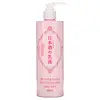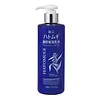What's inside
What's inside
 Key Ingredients
Key Ingredients

 Benefits
Benefits

 Concerns
Concerns

 Ingredients Side-by-side
Ingredients Side-by-side

Water
Skin ConditioningGlycerin
HumectantParaffinum Liquidum
EmollientTriethylhexanoin
MaskingRice Ferment Filtrate
Skin ConditioningGlutamic Acid
HumectantArginine
MaskingLeucine
Skin ConditioningGlycine
BufferingCeramide EOP
Skin ConditioningCeramide NP
Skin ConditioningCeramide AP
Skin ConditioningPlacental Protein
HumectantArbutin
AntioxidantDipotassium Glycyrrhizate
HumectantCholesterol
EmollientPhytosphingosine
Skin ConditioningSodium Lauroyl Lactylate
EmulsifyingPEG-9
HumectantDimethicone
EmollientPEG-20 Sorbitan Isostearate
EmulsifyingCarbomer
Emulsion StabilisingXanthan Gum
EmulsifyingDisodium EDTA
Phytic Acid
Behenyl Alcohol
EmollientPotassium Hydroxide
BufferingSilver Oxide
AntimicrobialPhenoxyethanol
PreservativeParfum
MaskingAcrylates/C10-30 Alkyl Acrylate Crosspolymer
Emulsion StabilisingWater, Glycerin, Paraffinum Liquidum, Triethylhexanoin, Rice Ferment Filtrate, Glutamic Acid, Arginine, Leucine, Glycine, Ceramide EOP, Ceramide NP, Ceramide AP, Placental Protein, Arbutin, Dipotassium Glycyrrhizate, Cholesterol, Phytosphingosine, Sodium Lauroyl Lactylate, PEG-9, Dimethicone, PEG-20 Sorbitan Isostearate, Carbomer, Xanthan Gum, Disodium EDTA, Phytic Acid, Behenyl Alcohol, Potassium Hydroxide, Silver Oxide, Phenoxyethanol, Parfum, Acrylates/C10-30 Alkyl Acrylate Crosspolymer
Dipotassium Glycyrrhizate
HumectantAllantoin
Skin ConditioningSodium Hyaluronate
HumectantCoix Lacryma-Jobi Ma-Yuen Seed Extract
Skin ConditioningGlycerin
HumectantDipropylene Glycol
HumectantPEG/PPG/Polybutylene Glycol-8/5/3 Glycerin
HumectantMethyl Gluceth-10
EmulsifyingCitric Acid
BufferingSodium Citrate
BufferingMethylparaben
PreservativePhenoxyethanol
PreservativeStyrene/Acrylamide Copolymer
Butylene Glycol
HumectantPEG-60 Hydrogenated Castor Oil
EmulsifyingPrunus Persica Leaf Extract
EmollientSoluble Collagen
HumectantSodium Hydroxide
BufferingXanthan Gum
EmulsifyingDipotassium Glycyrrhizate, Allantoin, Sodium Hyaluronate, Coix Lacryma-Jobi Ma-Yuen Seed Extract, Glycerin, Dipropylene Glycol, PEG/PPG/Polybutylene Glycol-8/5/3 Glycerin, Methyl Gluceth-10, Citric Acid, Sodium Citrate, Methylparaben, Phenoxyethanol, Styrene/Acrylamide Copolymer, Butylene Glycol, PEG-60 Hydrogenated Castor Oil, Prunus Persica Leaf Extract, Soluble Collagen, Sodium Hydroxide, Xanthan Gum
 Reviews
Reviews

Ingredients Explained
These ingredients are found in both products.
Ingredients higher up in an ingredient list are typically present in a larger amount.
Dipotassium Glycyrrhizate comes from licorice root.
Extracts of licorice have demonstrated to have antibacterial, anti‐inflammatory, antiviral, antioxidant properties.
One component, glabridin, has extra potent antioxidant and soothing properties. It has also been found to block pigmentation from UVB rays in guinea pigs.
Licorice Root also contains a flavonoid. Flavonoids are a natural substance from in plants. Flavonoids also have antioxidant properties.
Another component, glycyrrhizin, has been found to have anti-inflammatory and antimicrobial benefits. This may make licorice root extract effective at treating acne. However, more research is needed to support this.
Liquiritin is one of the flavone compounds found in licorice. It has been found to help lighten skin by preventing tyrosinase from reacting with tyrosine. When the two react, protein is converted to melanin. Melanin is the substance in your body that gives your features pigmentation.
Licorice root is native to Southern Europe and Asia. It has been used in traditional Chinese medicine to help with respiratory issues.
Learn more about Dipotassium GlycyrrhizateGlycerin is already naturally found in your skin. It helps moisturize and protect your skin.
A study from 2016 found glycerin to be more effective as a humectant than AHAs and hyaluronic acid.
As a humectant, it helps the skin stay hydrated by pulling moisture to your skin. The low molecular weight of glycerin allows it to pull moisture into the deeper layers of your skin.
Hydrated skin improves your skin barrier; Your skin barrier helps protect against irritants and bacteria.
Glycerin has also been found to have antimicrobial and antiviral properties. Due to these properties, glycerin is often used in wound and burn treatments.
In cosmetics, glycerin is usually derived from plants such as soybean or palm. However, it can also be sourced from animals, such as tallow or animal fat.
This ingredient is organic, colorless, odorless, and non-toxic.
Glycerin is the name for this ingredient in American English. British English uses Glycerol/Glycerine.
Learn more about GlycerinPhenoxyethanol is a preservative that has germicide, antimicrobial, and aromatic properties. Studies show that phenoxyethanol can prevent microbial growth. By itself, it has a scent that is similar to that of a rose.
It's often used in formulations along with Caprylyl Glycol to preserve the shelf life of products.
Xanthan gum is used as a stabilizer and thickener within cosmetic products. It helps give products a sticky, thick feeling - preventing them from being too runny.
On the technical side of things, xanthan gum is a polysaccharide - a combination consisting of multiple sugar molecules bonded together.
Xanthan gum is a pretty common and great ingredient. It is a natural, non-toxic, non-irritating ingredient that is also commonly used in food products.
Learn more about Xanthan Gum